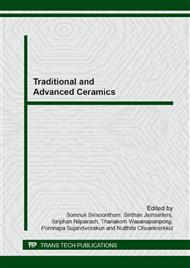[1]
G.H. Haertling, Ferroelectric ceramics: history and technology, J. Am. Ceram. Soc. 82 (4) (1999) 797-818.
Google Scholar
[2]
T.R. Shrout and S.J. Zhang, Lead-free piezoelectric ceramics: Alternatives for PZT? J. Electroceramics. 19 (2007) 113-126.
DOI: 10.1007/s10832-007-9047-0
Google Scholar
[3]
Y. Saito, H. Takao, T. Tani, T. Nonoyama, K. Takatori, T. Homma, T. Nagaya and M. Nakamura, Lead-free piezoceramics, Nature 432 (2004) 84-86.
DOI: 10.1038/nature03028
Google Scholar
[4]
G.Z. Zang, J.F. Wang, H.C. Chen, W.B. Su, C.M. Wang, P. Qi, B.Q. Ming, J. Du and LM. Zheng, Perovskite (Na0. 5K0. 5)1−x(LiSb)xNb1−xO3 lead-free piezoceramics, Appl. Phys. Lett. 88 (2006) 212908-212911.
DOI: 10.1063/1.2206554
Google Scholar
[5]
C.W. Ahn, C.S. Park, C.H. Choi, S. Nahm, M.J. Yoo, H.G. Lee and S. Priya, Sintering behavior of lead-free (K, Na)NbO3-based piezoelectric ceramics, J. Am. Ceram. Soc. 92 (2006) 2033-(2038).
DOI: 10.1111/j.1551-2916.2009.03167.x
Google Scholar
[6]
C.S. Yu and H.L. Hsieh, Piezoelectric properties of Pb(Ni1/3Sb2/3O3-PbTiO3-PbZrO3) ceramics modified with MnO2 additive, J. Eur. Ceram. Soc. 25, (2005) 2425-2427.
DOI: 10.1016/j.jeurceramsoc.2005.03.075
Google Scholar
[7]
J. H. Moon, H. M. Jang and B. D. You, Densification behaviors and piezoelectric properties of MnO2, SiO2-doped Pb(Ni1/3Nb2/3)O3-PbTiO3-PbZrO3 ceramics, J. Mater. Res. 8 (1993) 3184-3191.
DOI: 10.1111/j.1151-2916.1993.tb03825.x
Google Scholar
[8]
S. Wongsaenmai, K. Kanchiang, S. Chandarak, Y. Laosiritaworn, S. Rujirawat and R. Yimnirun, Crystal structure and ferroelectric properties of Mn-doped (K0. 5Na0. 5)0. 935Li0. 065)NbO3 lead-free ceramics, Curr. App. Phys. 12 (2012) 418-421.
DOI: 10.1016/j.cap.2011.07.040
Google Scholar
[9]
U. Flǜckiger, H. Arend and H. Oswald, Synthesis of KNbO3 Powder, J. Am. Ceram. Soc. 56(6) (1977) 575-577.
Google Scholar
[10]
R.D. Shannon, Revised effective ionic radii and systematic studies of interatomic distances in halides and chalcogenides. Acta Cryst. A32 (1976), 751-767.
DOI: 10.1107/s0567739476001551
Google Scholar
[11]
C. Galassi, E. Roncari, C. Capiani, F. Craciun, Processing and characterization of high Qm ferroelectric ceramics, J. Eur. Ceram. Soc. 19 (1999) 1237-1241.
DOI: 10.1016/s0955-2219(98)00410-5
Google Scholar
[12]
C.L. Huang, R.J. Lin and H.L. Chen, Microwave dielectric properties and microstructures of CuO- and ZnO-doped LaAlO3 ceramics, Mater. Res. Bull. 37 (2002) 449-457.
DOI: 10.1016/s0025-5408(01)00818-2
Google Scholar
[13]
P. Bomlai, P. Sinsap, S. Muensit and S. J. Milne, Effect of MnO on the phase development, microstructures and dielectric properties of 0. 95Na0. 5K0. 5NbO3-0. 05LiTaO3 ceramics. J. Am. Ceram. Soc. 91 (2008) 624-627.
DOI: 10.1111/j.1551-2916.2007.02130.x
Google Scholar
[14]
E. Li, H. Kakemoto, S. Wada and T. Tsurumi, Effects of manganese addition on piezoelectric properties of the (K, Na, Li) (Nb, Ta, Sb)O3 lead-free ceramics, J. Ceram. Soc. Jpn. 115(4), (2007) 250-253.
DOI: 10.2109/jcersj.115.250
Google Scholar


